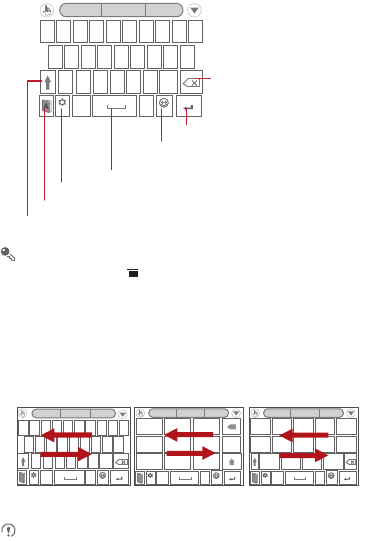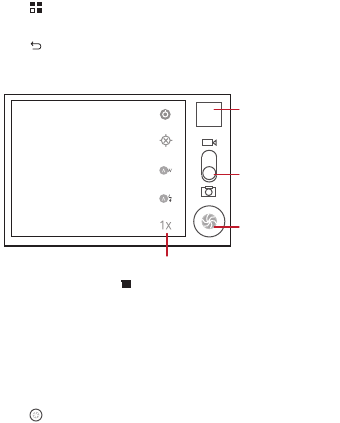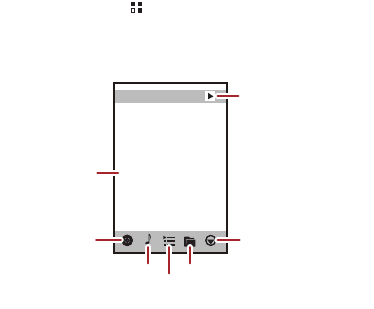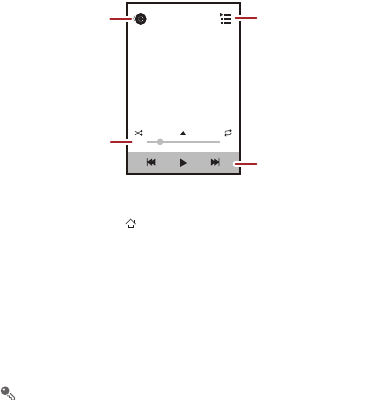Huawei Technologies U8815-71 HUAWEI U8815-71, U8815-71 is a mobile phone with GSM/WCDMA, Bluetooth, WLAN User Manual User guide part2
Huawei Technologies Co.,Ltd HUAWEI U8815-71, U8815-71 is a mobile phone with GSM/WCDMA, Bluetooth, WLAN User guide part2
Contents
- 1. User guide part1
- 2. User guide part2
- 3. User guide part3
- 4. Safety information
User guide part2

21
4.5 Searching for a Contact
1. In the contact list, touch >
Search
.
2. Enter the name of the contact you wish to search for. As you type, contacts with
matching names appear below the search box.
On the contact list screen, you can touch a letter on the right to display contacts
starting with the touched letter.
4.6 Editing a Contact
You can make changes to the information you have stored for a contact at any time.
1. In the contacts list, touch and hold the contact whose details you want to edit, and
then touch
Edit contact
in the options menu.
2. Touch the category of contact information you wish to change: name, phone
number, email address, or any other information you recorded earlier.
3. Make the desired changes to the contact information, and then touch
Save
. To
cancel all of your changes, touch
Cancel
.
4.7 Communicating with Your Contacts
From the
Contacts
or
Favorites
tab, you can quickly call or send a text (SMS) or
multimedia (MMS) message to a contact’s default phone number. You can also open
details to view a list of all the ways you can communicate with that contact. This
section describes how to communicate with a contact when you view your contacts
list.
4.7.1 Using Quick Contact for Android
1. Touch the contact's picture or picture frame (if you have not assigned a picture to
the contact) to open Quick Contact for Android.
2. Touch the icon for the way you want to communicate with the contact.
The icons available depend on the information you have entered for the contact,
the applications installed on your phone, and the accounts you have.

22
4.7.2 Communicating with a Contact
1. In the contacts list, touch the contact that you want to communicate with.
2. On the contact’s details screen, touch the icon to the right of the number to call or
send messages.
4.8 Deleting a Contact
1. In the contacts list, touch and hold the contact that you want to delete, and then
touch
Delete contact
in the options menu.
2. Touch
OK
to confirm that you want to delete the contact.
4.9 Backing Up and Synchronizing
Contacts
You can back up contacts from your phone to a microSD card, or synchronize phone
contacts with a server using your Google account.
4.9.1 Using a microSD Card to Back Up Contacts
Backing Up Contacts
1. In the contact list, touch >
Manage contacts
.
2. Touch
Backup to SD card
in the displayed menu.
3. Touch
OK
to export your phone contact's information to the installed microSD card.
You can copy the .vcf files backed up on the microSD card to your computer. The files
are stored in the microSD card's
Contact
folder.
Restoring Contacts
1. In the contact list, touch >
Manage contacts
.
2. Touch
Restore from SD card
in the displayed menu.
If there is more than one .vcf files saved on the microSD card, you can choose to
restore one, multiple, or all the of them.

23
4.9.2 Using a Google Account to Synchronize Contacts
You can synchronize contacts using your Google account. For details, see Changing
an Account’s Synchronization Settings.
4.10 Managing Groups
4.10.1 Creating a Group
1. On the Home screen, touch >
Contacts
. Then flick the tab bar to the left and
touch
Groups
.
2. In the groups list, touch , and then touch
Create group
.
3. Enter the name and picture you want to assign to the group, and then set a ringtone
for it.
4. Touch >
Add Members
to add members to the group.
5. Select the contacts to be added to the group, and then touch
OK
.
6. When you are finished, touch
Save
to save the group information.
You can only add contacts saved in the phone memory to a group.
4.10.2 Editing a Group
You can always make changes to the information you have saved for a group.
1. In the groups list, touch and hold the group whose details you want to edit, and then
touch
Edit group
in the options menu.
2. Make the desired changes to the group information, and then touch
Save
. To
cancel all changes you made to the group information, touch
Cancel
.
4.10.3 Adding a Contact to Your Groups
To add a contact to your groups, you can do any of the following:
• Touch and hold the contact you want to add to
Groups
. Then touch
Add to
groups
.
• When editing a group, touch , and then touch
Add Members
to select the
contacts you want to add to group.

24
4.11 Joining and Separating Contacts
You may have duplicate contacts if you import contacts by:
• Adding an account, such as a Gmail account.
• Using the social networking services such as Facebook or Twitter. (If your phone
has the Streams function, you can use it to access Facebook or Twitter.)
• Using other methods, such as exchanging emails.
To avoid duplication, join two or more contacts together to form a single contact.
Availability of Facebook or Twitter may vary depending on your country or
carrier. Please use them according to local laws and regulations.
4.11.1 Joining Contacts
1. On the Home screen, touch >
Contacts
.
2. Touch a duplicated contact.
3. Touch
Joined Contacts
, and then touch
Add contact
.
4. Select the contact to be joined to combine two duplicate contacts.
Two contacts will be joined together and displayed as one contact. Touch the contact
to view the joined information. You can see that the contact is joined together by two
contacts. You can also combine more than two contacts.
4.11.2 Separating Contacts
If contact information from different sources was joined together in error, you can
separate the contacts.
1. On the Home screen, touch >
Contacts
.
2. Touch the joint contact to be separated.
3. Touch the option for separating a contact.
4. Select the contact to be separated from the joint contact.
The joint contact is then separated into two contacts displayed separately in
Contacts
.

25
4.12 Sending Contacts
You can send contacts as a .vcf file via Bluetooth or Email.
1. In the contacts list, touch .
2. Select contacts that you want to send.
3. Touch
Send
.
4. Select the way you prefer to send the contacts you have selected, for example
Bluetooth or Email.
You can send one contact by another way. Touch and hold a contact, touch
Send contact
, and then select the way you prefer to send.
5 Using the Onscreen Keyboard
5.1 Displaying the Keyboard
To enter text, use the onscreen keyboard. Some applications open the keyboard
automatically. In others, touch a text field to open the keyboard.
Touch to hide the keyboard.
Touch and hold a text field to open the
Edit text
menu.
5.1.1 Choosing an Input Method
1. Touch and hold a text field until the
Edit text
menu is displayed.
2. Touch
Select input method
.
3. Select the input method.

26
5.1.2 Using the TouchPal keyboard
If you would like to learn how to use the onscreen keyboard, you can open a
tutorial anytime under >
Settings
>
About phone
>
System tutorial
.
5.1.3 Switching the Keyboard Layout
You can switch the keyboard layout only when
TouchPal
is selected.
There are three keyboard layouts for you to choose:
Full QWERTY
,
12-Key
PhonePad
and
CooTek T+
.
To switch the keyboard layout, touch and hold one side of the keyboard panel, and
then flick the panel to the edge of the screen.
When you switch the keyboard layout, you need to touch and hold anywhere on
the panel and then flick the panel to the edge of the screen.
,12#
EN
.
a
(s
)d
:f
;
g
?h
!j
”k
-
z x
/c
\v
-b
$
nm
l
‘
€
q
1w
2e
3r
4ty
6u
7io
9p
0
85
@&
Touch to change from uppercase to lowercase.
Touch to enable word prediction.
Touch to insert a space.
Touch to delete a character
to the left of the cursor.
Touch and hold to delete
all characters to the left of
the cursor.
Touch to set the language for your mobile phone.
Touch to switch to the numbers and symbols
keyboard panel.
Touch to add a line break.
2
Full QWERTY 12-Key-PhonePad CooTek T+
A
,
12#
EN
.
A
q w
1
e r
2
t y
3
u i
4o p
5
a s
6
d f
7
g h
8
j k
9l -
0
z x
@
c v
!
b n
?
m ’
/
,
12#
EN
.
a
(
s
)
d
:
f
;
g
?h
!j
”k
-
z x
/c
\v
-b
$
nm
l
‘
€
q
1w
2e
3r
4ty
6u
7io
9p
0
85
@&
abc
'-@.
def
,
12#
EN
.
A
123
jkl
ghi
mno
456
tuv
pqrs
wxyz
789
-
0
x

27
5.1.4 Using the Landscape Keyboard
If you find the keyboard inconvenient or difficult to use, turn your mobile phone
sideways. The screen will display the keyboard in landscape orientation, providing
you with a wider keyboard layout.
5.2 Customizing Keyboard Settings
1. On the Home screen, touch >
Settings
>
Language & keyboard
.
2. In
Keyboard settings
, select an input method to customize the keyboard settings.
6 Messaging
The
Messaging
application allows you to exchange text messages (SMS) and
multimedia messages (MMS) with anyone using an SMS-or-MMS-capable phone.
With the
Email
application you can read and send emails.
6.1 SMS and MMS
6.1.1 Opening Messaging
Touch >
Messaging
.
6.1.2 Creating and Sending a Text Message
1. Touch >
Messaging
>
New message
.
2. Enter a phone number or a contact's name in the
To
field, or touch to select a
contact from
Contacts
or
Groups
.
As you enter the phone number or the contact's name, the phone displays
possible matches from your contacts. Select a contact from the list of possible
matches or continue entering.
After you select a contact or finish entering a number, add a comma and you can
enter another recipient. You can also touch a previously entered contact again
to edit or delete it.
3. Touch the composition text box to start entering your message.

28
4. When you are ready to send the message, touch .
Sent and received messages will be displayed in a message thread, grouping
together the messages in a conversation.
6.1.3 Creating and Sending a Multimedia Message
You can use multimedia messages to make everyday communications very special.
You can record a message and send it as an audio file, sing 'Happy Birthday' and
send it to friend, or send a slideshow of photographs of a special event. The
possibilities are endless.
1. Touch >
Messaging
>
New message
.
2. Enter a phone number in the
To
field, or touch to select a contact from
Contacts
or
Groups
.
3. Touch the composition text box to start entering your message.
4. Touch to display the options panel.
• Touch
Add subject
to add the message subject. Your mobile phone is now in
multimedia message mode.
• Touch
Add
to add a picture, music, or video file.
5. When the message is ready to be sent, touch .
You can select a media file (music, video or picture) and send it as an attachment
in a multimedia message. In
File Manager
, touch and hold a media file, and then
touch
Share
>
Messaging
.
Adding a Slide Show
If you want to attach more than one file to your message, use the
Slide show
option.
1. On the message editing screen, touch to display the options panel.
2. Touch
Add
>
Slideshow
, and then select a slide to start editing it.
3. Touch and then touch
Add slide
to add more slides.
4. Touch
Done
to finish composing your message and return to the multimedia
message screen.
5. To alter your multimedia message, touch the slideshow on the multimedia
message screen. When the message is ready to be sent, touch .

29
6.1.4 Opening and Viewing a Multimedia Message
1. In the message list, touch the message thread you wish to view.
2. Touch the multimedia message to view the message.
6.1.5 Replying to a Message
1. In the message list, touch a text or multimedia message thread to open it.
2. Touch the text box to compose your message. Once finished, touch .
You can also do the following to reply to a message: Touch >
Multiselect
,
select one or more message threads, and touch
Reply
.
6.1.6 Copying a Text Message to Notepad or Calendar
1. In the message list, touch a text message thread to open it.
2. Touch and hold one of the messages, and then touch
Copy message to
.
3. Touch
Notepad
or
Calendar
to save it as a note or an event.
For information about how to use
Notepad
or
Calendar
, see the relevant sections of
this guide.
6.1.7 Customizing Message Settings
In the message list, touch , and then touch
Settings
to customize the message
settings.
6.2 Email
Your mobile phone also puts email at your fingertips. With your phone’s
Email
application, you can use your email account with Yahoo!, AOL, or other popular email
services on your phone.
6.2.1 Adding an Email Account
When using the
Email
application for the first time, you must configure an email
account. The Email setup wizard helps you to configure your account. A number of
popular email systems are supported. You can work with the same email service that
you use on your PC or you can select another email service.

30
1. On the Home screen, touch >
Email
.
2. In the email system list, select a system, or select
Others
.
3. To customize your email settings, follow the onscreen instructions, and then touch
Next
.
4. Enter the account name and the name you want other people to see when they
receive an email from you.
5. Touch
Done
.
Adding Other Email Accounts
1. After creating your initial email account, touch on the
Inbox
screen, and then
touch
More
>
Accounts
to access the accounts screen.
2. Touch on the accounts screen, and then touch
Add account
to create
another email account.
When adding an additional email account, you have the option to use the new
account to send all outgoing messages.
6.2.2 Viewing an Email Message
1. On the accounts screen, touch the email account you want to use.
2. Access a folder, and then touch the message that you want to view.
6.2.3 Saving an Email Attachment
1. On the accounts screen, touch the email account you want to use.
2. Touch the email message you want to view.
3. Touch
Save
next to the attachment in the email.
4. Select a path for saving the attachment and touch
Save
.
6.2.4 Creating and Sending an Email Message
1. On the accounts screen, touch the email account you want to use.
2. On the
Inbox
screen, touch , and then touch
Compose
in the options panel.
3. In the
To
field, enter the recipients’ name or email address.

31
4. Enter the subject of your message and compose the message.
To send an attachment with the message, touch , and then touch
Add
attachment
.
5. When you are finished, touch
Send
.
If you are not ready to send the message, touch
Save as draft
or touch to
save the message as a draft.
6.2.5 Replying to an Email Message
1. On the accounts screen, touch the email account you want to use.
2. Touch the email message to which you want to reply.
3. Touch
Reply
or
Reply all
to reply to the email message.
6.2.6 Deleting an Email Account
1. On the accounts screen, touch and hold the email account you want to delete.
2. Touch
Remove account
.
3. Touch
OK
.
6.2.7 Changing Email Account Settings
You can change a number of account settings, including how often you check for
emails, how you are notified of a new mail, and details about the servers the account
uses to send and receive mails.
Your account’s incoming and outgoing settings depend on the kind of email
service you are using. You can enter the necessary details manually, although
you may need to contact your email service provider to obtain the correct
information.
1. Touch >
Email
.
2. On the accounts screen, touch and hold the email account you want to change.
3. Touch
Account settings
.
4. Change
General settings
,
Notification settings
, or
Server settings
.

32
7 Getting Connected
7.1 Mobile Networks
Your mobile phone will be automatically configured to use your network operator’s
2G/3G service (if available) when you turn on the phone for the first time. Note that the
SIM/UIM card must be inserted (some CDMA mobile phones have an integrated UIM
card and do not need a separate UIM card)
7.1.1 Checking the Network Connection
1. Touch >
Settings
.
2. Touch
Wireless & networks
>
Mobile networks
>
Network Settings
.
3. Touch
Network operators
or
Access Point Names
to check the network
connection.
Your mobile phone will automatically read the access point settings from the
SIM/UIM card (if any). For this reason, do not change the access point
parameters; otherwise, you might not be able to access network resources.
7.1.2 Turning on the Data Service
1. Touch >
Settings
.
2. Touch
Wireless & networks
>
Mobile networks
.
3. Select the
Data enabled
check box to turn on the data connection.
7.2 Wi-Fi
Wi-Fi gives you wireless access to broadband Internet. To use Wi-Fi on your mobile
phone, you must have an access to wireless access points (hotspots). Obstacles that
block the Wi-Fi signal will reduce its strength.
7.2.1 Turning On Wi-Fi
1. Touch >
Settings
.
2. Touch
Wireless & networks
, and then select the
Wi-Fi
check box to turn on Wi-Fi.

33
7.2.2 Connecting to a Wireless Network
1. After turning on Wi-Fi, touch >
Settings
.
2. Touch
Wireless & networks
>
Wi-Fi settings
. You will see a list of detected Wi-Fi
networks in the
Wi-Fi networks
section.
3. Touch a Wi-Fi network to connect to it.
• If you select an open network, you will be automatically connected to the
network.
• If you select a network that is secured with Wired Equivalent Privacy (WEP)
and connect to it for the first time, enter the password as prompted, and then
touch
Connect
. If you connect to a secured wireless network that you have
already used, you will not be prompted to enter the password again unless you
have reset your mobile phone to its default settings.
On the
Wi-Fi settings
screen, touch
Add Wi-Fi network
to add a new Wi-Fi
network.
7.3 Sharing Your Phone’s Data
Connection
You can share your mobile phone's data connection with a single computer via a USB
cable: USB tethering. You can share your mobile phone's data connection with a
number of devices at the same time, by turning your phone into a portable Wi-Fi
hotspot.
7.3.1 Installing the USB tethering Driver
If your computer is running Windows 7 or a recent distribution of some flavors of Linux
(such as Ubuntu), you typically do not need to prepare your computer for tethering.
But if you are running an earlier version of Windows or another operating system, you
may need to prepare your computer to establish a network connection via USB.
Install the
USB tethering
driver in the following steps:
1. Connect a USB cable to a computer. The computer will automatically recognize the
phone.
2. Choose
Start
>
My Computer
, and then double-click
Mobile Partner
.

34
3. Open the
drivers
folder and then open the
usbnet_driver_win2k_xp
folder.
Double-click the link
DownloadActiveSync
.
4. Download and install
ActiveSync 4.5
or a later version.
5. After the installation, you are able to use USB tethering.
7.3.2 Sharing Your Phone’s Data Connection via USB
To use USB tethering in different operating systems, you may need to prepare your
computer to establish a network connection via USB.
You cannot share your mobile phone’s data connection and access its microSD
card via USB at the same time.
1. Touch >
Settings
.
2. Touch
Wireless & networks
>
Tethering & portable hotspot
.
3. Select the
USB tethering
check box to share your data connection.
7.3.3 Sharing Your Phone’s Data Connection as a Portable
Wi-Fi Hotspot
1. Touch >
Settings
.
2. Touch
Wireless & networks
>
Tethering & portable hotspot
.
3. Select the
Portable Wi-Fi hotspot
check box to share your data connection.
When
Portable Wi-Fi hotspot
is selected, you can touch
Portable Wi-Fi
hotspot settings
to change its network name or secure it.
7.4 Browser
Your mobile phone comes with an Internet browser pre-installed.
7.4.1 Opening the Browser
Touch >
Browser
to open the homepage.
When known or open Wi-Fi networks and mobile data networks are available at
the same time, your phone will preferably select a Wi-Fi network for Internet
access.

35
Touch to open the browser options menu and perform one of the following
operations:
•
New window
: Touch to open a new window.
•
Bookmarks
: Touch to display bookmarks.
•
Windows
: Touch to view thumbnails of open browser windows. You can switch to
another browser window or open a new one on this screen.
•
Refresh
: Touch to refresh the current webpage.
•
Forward
: Touch to browse the next web page.
•
More
: Touch to open other menus and perform operations such as searching,
selecting text, downloading, or setting options.
7.4.2 Opening a Webpage
1. In a browser window, touch the URL field at the top of the screen.
2. Use the keyboard to enter a webpage address. You can touch to enter the
web page address by voice.
3. As you enter the address, matching webpage addresses will appear on the screen.
If you see the address you want, touch it and go directly to that webpage or
complete entering your desired webpage.
7.4.3 Setting a Homepage
1. In a browser window, touch .
2. Touch
More
>
Settings
>
Set home page
.
3. Enter the address of the desired homepage, and then touch
OK
.
7.4.4 Managing Bookmarks
You can store as many bookmarks as you want on your mobile phone.
Adding a Bookmark
1. In a browser window, go to the webpage you want to save as a bookmark.
2. Touch , and then touch
Bookmarks
>
Add
.
3. Edit the bookmark name and then touch
OK
.

36
Opening a Bookmark
1. In a browser window, touch , and then touch
Bookmarks
.
On the
Bookmarks
screen, touch the
History
tab to view the pages you have
visited, or touch the
Most visited
tab to view the pages you have visited most
frequently.
2. Touch the bookmark of the website you want to open.
7.4.5 Customizing Browser Settings
Customize the browser to suit your browsing style. Use
Browser
to set page content,
privacy, and security preferences. In a browser window, touch , and then touch
More
>
Settings
.
7.5 Bluetooth
Your mobile phone has Bluetooth, which allows you to create a wireless connection
with other Bluetooth devices so you can share files with your friends, talk hands-free
with a Bluetooth headset, or even transfer photos from your phone to your PC.
If you are using Bluetooth, remember to stay within 10 meters (33 feet) of the other
Bluetooth devices to which you want to connect. Be aware that obstacles like walls or
other electronic equipment may interfere with your Bluetooth connection.
7.5.1 Turning On Bluetooth
1. Touch >
Settings
.
2. Touch
Wireless & networks
, and then select the
Bluetooth
check box to turn on
Bluetooth. When Bluetooth is turned on, the Bluetooth icon appears in the
notification bar.
3. Touch
Bluetooth settings
, and then select the
Discoverable
to make your
mobile phone visible to other Bluetooth devices.
7.5.2 Pairing with and Connecting to a Bluetooth Device
Your mobile Bluetooth lets you do the following:
• Hands Free Profile (HFP): allows you to use a hands-free Bluetooth device.
• Headset Profile (HSP): allows you to use a mono Bluetooth headset.

37
• Object Push Profile (OPP): allows you to transfer files over a Bluetooth connection.
• Advanced Audio Distribution Profile (A2DP): allows you to use a stereo Bluetooth
headset.
• A/V Remote Control Profile (AVRCP): allows you to control audio playing using a
Bluetooth headset remotely.
Before you use Bluetooth, pair your mobile phone with another Bluetooth device as
follows:
1. Ensure that the Bluetooth function on your mobile phone is enabled.
2. On the Home screen, touch >
Settings
>
Wireless & networks
>
Bluetooth
settings
. Your mobile phone will then scan for Bluetooth devices in range.
3. Touch the device you want to pair your mobile phone with.
4. If required, enter the pairing password to complete the connection.
7.5.3 Sending Files via Bluetooth
With Bluetooth, you can share pictures, videos, or music files with your family and
friends. To send files via Bluetooth:
1. Touch and hold the file to be sent in your mobile phone or SD card. The active
options menu is displayed.
2. Touch
Share
, then
Bluetooth
to select a paired device.
7.5.4 Disconnecting from or Unpairing with a Bluetooth Device
1. Touch >
Settings
>
Wireless & networks
>
Bluetooth settings
.
2. Navigate to the
Bluetooth devices
section, and then touch and hold the device to
which you are connected.
3. Touch
Don't Pair
to disconnect from the device.
8 Entertainment
In addition to being a communication device and personal assistant, your mobile
phone also provides you with a multitude of entertainment possibilities. You can take
photos, create videos and audio clips, and download and listen to music.

38
8.1 Taking Photos and Recording Videos
The camera is a combination of camera and camcorder that you can use to shoot and
share pictures and videos.
8.1.1 Opening Your Camera
• Touch >
Camera
to open the camera. The camera opens in landscape
mode, ready to take a picture or record a video.
• Touch to close the camera.
Capture Screen
On the capture screen, touch to show the capture panel.
8.1.2 Taking a Photo
1. Open your camera application and switch it to camera mode.
2. If necessary, change the camera settings. The preview changes as you change
the settings.
3. Frame your photo within the photo capture screen.
4. Touch to take your photo.
Photos taken are displayed for a moment. You can take another photo or review your
photos.
3
5
Touch to customize the camera settings.
Thumbnail of the
last photo. Touch
to preview the
photos or videos.
Slide up to record
videos; slide down
to take photos.
Touch to take a
photo.

39
8.1.3 Viewing Your Photos
1. After taking a photo, a thumbnail of the photo you have just taken is shown in the
upper right corner of the capture screen. Touch the thumbnail to view it.
2. Touch the onscreen button to do any of the following:
• Touch
Share
to send the photo in a message or post it online.
• Touch
Delete
to delete the photo.
• Touch
More
>
Set as
to set the photo as a contact icon or the wallpaper.
8.1.4 Recording a Video
1. Open the camera application, and then switch it to camcorder mode.
2. If necessary, change the camcorder settings.
3. Frame the scene with which you want to start your video.
4. Touch to start recording a video.
5. Touch to stop recording.
8.1.5 Viewing Your Videos
1. After recording a video, a thumbnail of the video you have just recorded is shown in
the upper right corner of the capture screen. Touch the thumbnail to view it.
2. Touch the onscreen buttons to do any of the following:
• Touch
Share
to send the video in a message or post it online.
• Touch
Delete
to delete the video.
On the video playback screen, touch the controls to fast-forward or rewind or to
play or pause the video.
3. If you want to view more videos, flick your finger left or right across the screen.
8.2 Using the Gallery
Your
Gallery
application can automatically search for pictures and videos on your
mobile phone and microSD card. Use
Gallery
to sort photos and videos into folders,
view and edit pictures, watch videos, and set a picture as wallpaper or as a photo for
a contact.

40
8.2.1 Opening the Gallery
On the Home screen, touch >
Gallery
.
The
Gallery
application categorizes your pictures and videos by storage location and
displays these files in folders. Touch a folder to view the pictures or videos inside.
8.2.2 Viewing a Picture
1. In
Gallery
, touch the folder that contains the pictures you want to view.
2. Touch the picture to view it in full-screen mode.
3. Touch the screen. Then the zoom panel appears. You can zoom in or zoom out on
the picture.
The picture viewer supports the automatic rotation function. When you rotate
your mobile phone, the picture adjusts itself to the rotation.
8.2.3 Rotating a Picture
1. When viewing a picture, touch to display the operations panel.
2. Touch
More
.
3. Select either
Rotate Left
or
Rotate Right
. The picture is saved with the new
orientation.
8.2.4 Cropping a Picture
1. When viewing a picture, touch to display the operation panel, and then touch
More
>
Crop
.
2. Use the cropping tool to select the portion of the picture to crop.
• Drag from the inside of the cropping tool to move it.
• Drag an edge of the cropping tool to resize the image.
• Drag a corner of the cropping tool to resize the image without changing its
length to width ratio.
3. Touch
Save
to save the cropped picture. Touch
Discard
to discard the changes.

41
8.3 Enjoying Music
8.3.1 Opening the Music Library
On the Home screen, touch >
Music
to open the music library.
The music library automatically scans for music stored on your microSD card and
displays them in
Albums
,
Songs
,
Playlists
,
Folders
. Touch
More
to view music
in other ways.
Albums
Songs Folders
More
Media player screen
Main screen
Playlists

42
8.3.2 Playing Music
1. From the music library, select a way to view your music.
2. Touch the music file you want to play.
By default, the album cover is displayed while the music is playing. You can flick left or
right to switch to visualization effects or the lyrics screen.
While playing music, touch to return to the Home screen, the music will continue
to play in the background and you can use other applications. Open the notifications
panel and touch the playing music to return to the music playing screen.
8.3.3 Creating a Playlist
1. In the music library, enter
Playlists
, and touch
New playlist
to create a new
playlist.
2. After a playlist is created, touch
OK
to add songs.
3. Select the songs to be added to the playlist, and touch
Done
。
Touch and hold a playlist to
Rename
or
Delete
it.
8.3.4 Adding Music to a Playlist
1. From the music library select a way to view your music.
2. Touch and hold a music file, and then touch
Add to playlist
.
• Touch an existing playlist to add the song to that playlist.
• Touch
New playlist
to add the song to a new playlist.
Back Playlist screen
Music player controls
Progress bar

43
8.3.5 Playing Music in a Playlist
1. In music library, touch
Playlists
.
2. Touch and hold the playlist you want to play.
3. Touch
Play
to play the playlist.
8.4 Listening to the FM Radio
The FM radio lets you listen to FM radio programs on your mobile phone. Since the
FM radio uses the provided wired stereo headset as its antenna, before opening the
application, connect the headset to your phone’s the audio jack.
8.4.1 Opening the FM Radio
1. On the Home screen, touch >
FM Radio
to open the application.
2. The first time you open FM radio, touch
Auto tuning
, which automatically scans for
available FM channels, saves them as presets, and plays the first FM channel
found.
8.4.2 Tuning the FM Radio
Open the
FM Radio
application, and then do the following:
• Touch or to tune the radio to the previous or next channel.
• Slide the knob left or right to perform precision tuning. When a channel is found,
touch , then
Save channel
. Enter the channel name, touch
OK
, and then
select an empty channel to save the new channel to the channel list.
• Touch
Auto tuning
to scan automatically for available FM channels.
9 Google Services
Availability of Google applications, services, and features may vary according to
your country or carrier. Please follow local laws and regulations to use them.
When you turn on your mobile phone for the first time, touch a Google services such
as
Talk
,
Gmail
, or
Play Store
, and you will be prompted to sign in to your Google
account.

44
Ensure that your mobile phone has an active data connection (3G/GPRS)
before you sign in to your Google account.
If you already have a Google account, touch
Sign in
and enter your username and
password.
9.1 Creating a Google Account
If you do not have a Google account, you can create one:
1. After reading the setup information, touch
Next
.
2. Touch
Create
.
3. Enter the first name, last name, and user name for your Google account, and then
touch
Next
. The mobile phone will connect to a Google server to check whether the
username is available. If the username you entered is already in use, you will be
prompted to choose another one or select one from a list.
4. Enter and confirm your Google account password.
5. Select a security question from the drop-down menu, and then enter the answer.
6. Touch
Create
.
7. When the
Google Terms of Service
screen appears, touch
I agree, Next
.
8. Enter the characters that appear on the screen, and then touch
Next
.
To use another Google account, go to the
Accounts & sync settings
screen,
and touch
Add account
to select which type of accounts you want to add.
9.2 Gmail
Gmail
is Google’s web-based email service. When you first set up your phone, you
may have configured it to use an existing
Gmail
account or create a new account.
The first time you open the
Gmail
application on your phone, your
Inbox
will contain
the messages from your
Gmail
web account.
9.2.1 Opening Gmail
On the Home screen, touch >
Gmail
. The
Inbox
mail list appears. Any emails
you decide to keep on your mobile phone will go to your
Inbox
folder.